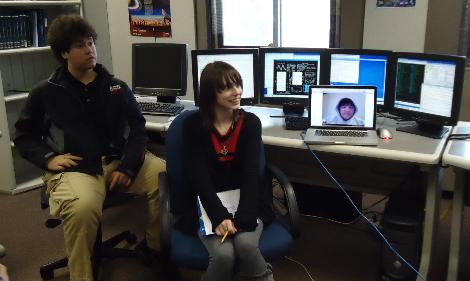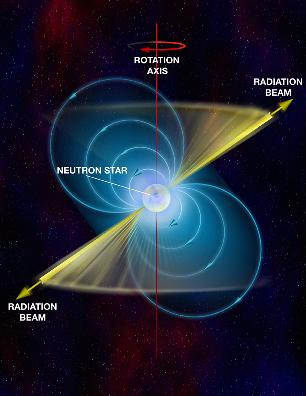February 2, 2011
Contact:
Sue Ann Heatherly
Green Bank, WV
(304) 456-2209
sheather@nrao.edu
In the constellation of Ophiuchus, above the disk of our Milky Way Galaxy, there lurks a stellar corpse spinning 30 times per second -- an exotic star known as a radio pulsar. This object was unknown until it was discovered last week by three high school students. These students are part of the Pulsar Search Collaboratory (PSC) project, run by the National Radio Astronomy Observatory (NRAO) in Green Bank, WV, and West Virginia University (WVU).

Casey Thompson on-screen, during confirmation observation. CREDIT: NRAO/AUI/NSF |
The pulsar, which may be a rare kind of neutron star called a recycled pulsar, was discovered independently by Virginia students Alexander Snider and Casey Thompson, on January 20, and a day later by Kentucky student Hannah Mabry. "Every day, I told myself, 'I have to find a pulsar. I better find a pulsar before this class ends,'" said Mabry.
When she actually made the discovery, she could barely contain her excitement. "I started screaming and jumping up and down."
Thompson was similarly expressive. "After three years of searching, I hadn't found a single thing," he said, "but when I did, I threw my hands up in the air and said, 'Yes!'."
Snider said, "It actually feels really neat to be the first person to ever see something like that. It's an uplifting feeling."
As part of the PSC, the students analyze real data from NRAO's Robert C. Byrd Green Bank Telescope (GBT) to find pulsars. The students' teachers -- Debra Edwards of Sherando High School, Leah Lorton of James River High School, and Jennifer Carter of Rowan County Senior High School -- all introduced the PSC in their classes, and interested students formed teams to continue the work.
Even before the discovery, Mabry simply enjoyed the search. "It just feels like you're actually doing something," she said. "It's a good feeling."
Once the pulsar candidate was reported to NRAO, Project Director Rachel Rosen took a look and agreed with the young scientists. A followup observing session was scheduled on the GBT. Snider and Mabry traveled to West Virginia to assist in the follow-up observations, and Thompson joined online.
"Observing with the students is very exciting. It gives the students a chance to learn about radio telescopes and pulsar observing in a very hands-on way, and it is extra fun when we find a pulsar," said Rosen.
Snider, on the other hand, said, "I got very, very nervous. I expected when I went there that I would just be watching other people do things, and then I actually go to sit down at the controls. I definitely didn't want to mess something up."
Everything went well, and the observations confirmed that the students had found an exotic pulsar. "I learned more in the two hours in the control room than I would have in school the whole day," Mabry said.

CREDIT: Bill Saxton, NRAO/AUI/NSF |
Pulsars are spinning neutron stars that sling lighthouse beams of radio waves or light around as they spin. A neutron star is what is left after a massive star explodes at the end of its normal life. With no nuclear fuel left to produce energy to offset the stellar remnant's weight, its material is compressed to extreme densities. The pressure squeezes together most of its protons and electrons to form neutrons; hence, the name neutron star. One tablespoon of material from a pulsar would weigh 10 million tons -- as much as a supertanker.
The object that the students discovered is in a special class of pulsar that spins very fast - in this case, about 30 times per second, comparable to the speed of a kitchen blender.
"The big question we need to answer first is whether this is a young pulsar or a recycled pulsar," said Maura McLaughlin, an astronomer at WVU. "A pulsar spinning that fast is very interesting as it could be newly born or it could be a very old, recycled pulsar."
A recycled pulsar is one that was once in a binary system. Material from the companion star is deposited onto the pulsar, causing it to speed up, or be recycled. Mystery remains, however, about whether this pulsar has ever had a companion star.
If it did, "it may be that this pulsar had a massive companion that exploded in a supernova, disrupting its orbit," McLaughlin said. Astronomers and students will work together in the coming months to find answers to these questions.
The PSC is a joint project of the National Radio Astronomy Observatory and West Virginia University, funded by a grant from the National Science Foundation. The PSC, led by NRAO Education Officer Sue Ann Heatherly and Project Director Rachel Rosen, includes training for teachers and student leaders, and provides parcels of data from the GBT to student teams. The project involves teachers and students in helping astronomers analyze data from the GBT, a giant, 17-million-pound telescope.
Some 300 hours of observing data were reserved for analysis by student teams. Thompson, Snider, and Mabry have been working with about 170 other students across the country. The responsibility for the work, and for the discoveries, is theirs. They are trained by astronomers and by their teachers to distinguish between pulsars and noise. The students' collective judgment sifts the pulsars from the noise.
All three students had analyzed thousands of data plots before coming upon this one. Casey Thompson, who has been with the PSC for three years, has analyzed more than 30,000 plots.
"Sometimes I just stop and think about the fact that I'm looking at data from space," Thompson said. "It's really special to me."
In addition to this discovery, two other astronomical objects have been discovered by students. In 2009, Shay Bloxton of Summersville, WV, discovered a pulsar that spins once every four seconds, and Lucas Bolyard of Clarksburg, WV, discovered a rapidly rotating radio transient, which astronomers believe is a pulsar that emits radio waves in bursts.
Those involved in the PSC hope that being a part of astronomy will give students an appreciation for science. Maybe the project will even produce some of the next generation of astronomers. Snider, surely, has been inspired.
"The PSC changed my career path," confessed Thompson. "I'm going to study astrophysics."
Snider is pleased with the idea of contributing to scientific knowledge. "I hope that astronomers at Green Bank and around the world can learn something from the discovery," he said.
Mabry is simply awed. "We've actually been able to experience something," she said.
The PSC will continue through 2011. Teachers interested in participating in the program can learn more at this link.
The National Radio Astronomy Observatory is a facility of the National Science Foundation, operated under cooperative agreement by Associated Universities, Inc.
